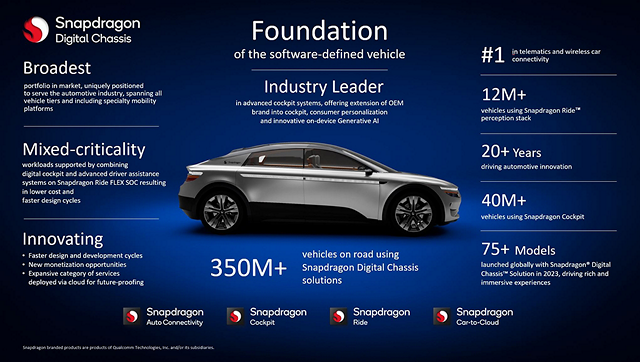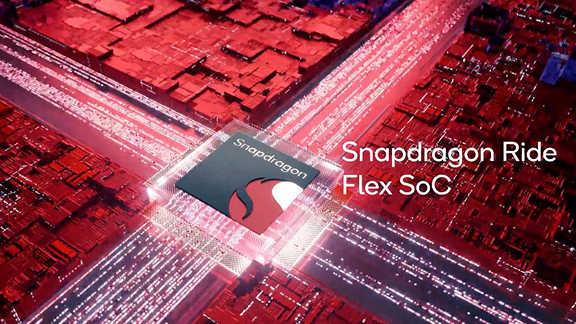The annual tech extravaganza CES has been making headlines, and it’s hard not to notice that automotive elements are increasingly prominent at the consumer electronics show.
Arguably, the hottest topic in the tech world in 2023 is generative AI. Particularly, the integration of AI with automobiles can significantly advance automotive intelligence. However, to create smarter vehicles, the ‘soul makers’ behind car companies play an even more crucial role. Qualcomm, one of the giants in the chip industry, is deepening its foothold in the automotive industry as well.
Before the opening of CES 2024, Nakul Duggal, Senior Vice President of Qualcomm Technologies and General Manager of Automotive and Cloud Computing, was interviewed by several domestic media outlets. Qualcomm’s digital chassis solutions showcased at CES offer us a more profound insight into its latest advancements in the field of intelligent vehicles.

Exploring Generative AI
In the mobile phone space, generative AI can assist you with various tasks. However, in a car, the difference in context necessitates a shift in the development thought process for generative AI.
Take AI drawing as an example, if used only for changing the wallpaper of the car’s screen, it might only appeal to users once. But, our previous experiences with AI drawing on the Galaxy E8 were strikingly different. Generating an image based on the title and lyrics of a song, with each song producing a unique visual experience, is a superior use case scenario.
For Qualcomm, while its products aim for latency, accuracy and optimization of modalities such as voice-to-text, text-to-image and text-to-text, it also aims to provide a sample to car companies, showcasing Qualcomm’s solutions.
As Nakul puts it, this is like a ‘virtual service manual’.
The Qualcomm digital chassis concept car showcased four cases:
- Travel Guide: Using generative AI to plan your travel route. This has been achieved by many domestic auto manufacturers already.
- User Manual: Replacing traditional car manuals, you can ask how to change a tire or install a roof rack, information that would usually require manual lookup.
- Predictive Maintenance: The vehicle can inform users about the meaning of each warning light and recommend maintenance or repair. You might be able to ask “What does the second warning light on the left mean?”
- Cabin Control and General Voice Query: Control car hardware with voice commands and ask questions to the voice assistant.
Additionally, these applications of generative AI can be achieved with existing hardware. According to Nakul, what Qualcomm strives to do is to make full use of the existing hardware infrastructure, complement it with a rich software framework, and assist ecosystem partners and customers in developing more functions.
Where Does the Differentiation Lie in the Same Chip?
Vehicles ranging from economy class cars priced as low as 150,000 yuan to luxury class cars priced in millions, all feature the Snapdragon cockpit platform. Interestingly, cars with several times the price difference are using the same chip.However, different automakers have different requirements for cockpit development. How does Qualcomm assist automakers in achieving customization and differentiation?
Nakul discussed that after understanding the developmental needs of automakers, Qualcomm provides a broad range of reference modules and software that are compatible with the hardware platforms. For the features that Qualcomm does not yet support, it would develop them and integrate them into the reference platforms.
“The smart cockpit is actually the best example of how automakers differentiate their products from their competitors,” said Nakul. “Providing comprehensive solutions for customers to achieve this differentiation is crucial.”
Is there room for further competition in China’s smart driving market?
A previous report stated that within domestic vehicles equipped with NOA assisted driving, Nvidia and Horizon’s market shares exceeded 80%. Further, the development of smart driving is incredibly complex, and once a chip and toolchain is selected from a manufacturer, switching would be similar to “starting from scratch.”

That is, a deep-seated bond has formed between the suppliers of smart driving chips and the automakers.
Facing this market situation, how does Qualcomm Snapdragon Ride breakthrough? The current answer is by breakthrough major automakers, the future answer lies in Snapdragon Ride Flex.
Two years ago, BMW left Mobileye, its longtime partner, and turned to the Snapdragon Ride platform to develop assisted driving, targeting it for release next year.
Additionally, General Motors, Volkswagen, Mercedes-Benz, and ten other automobile manufacturers and brands have partnered with Qualcomm, using the Snapdragon Ride platform to create ADAS and AD solutions.
At this year’s CES, ZYT and Momenta, two Tier 1 companies, exhibited their assisted driving solutions based on the Snapdragon Ride platform. City guide assist and cross-level memory parking functions were demonstrated on-site.
Perhaps in the near future, we will see more Qualcomm assisted driving solutions on domestic roads.
So, why is Snapdragon Ride Flex the future answer?
Let’s talk about the capabilities of Snapdragon Ride Flex first. This single chip can simultaneously support ADAS and cockpit functions, accomplishing cockpit integration.
That is to say, once an automaker has planned a cockpit solution based on Qualcomm, the same chip can be used to implement smart driving functions, achieving the central integration of the electronic and electrical architecture that the automotive industry has been chasing for years.
At the same time, most of the chips in the market aimed at smart driving are rarely utilized for cockpit applications.
In other words, if automakers do not use this solution, it means there are two other paths left to choose from.Firstly, only using Qualcomm’s cockpit solutions, but unable to implement a centralized electronic and electrical architecture as the intelligent driving solutions might come from other suppliers.
Secondly, abandon Qualcomm’s cockpit solutions, utilizing other providers’ solutions for both intelligent driving and intelligent cockpit systems to implement a centrally integrated electronic and electrical architecture.
During the interview, Nakul evaluated the Snapdragon Ride Flex, stating that “Customers only need to invest in a unit of universal hardware that can support a variety of different software functionalities. Qualcomm can provide extensive support globally, which is extremely pivotal for companies just stepping into the ADAS field.”
Facing the intelligent driving market in China, Nakul also mentioned that the current ADAS market in China is still in its growth phase, possessing vast potential for development. He believes that in the coming months or even years, the intelligent driving market will remain amid tremendous development opportunities.
This article is a translation by AI of a Chinese report from 42HOW. If you have any questions about it, please email bd@42how.com.
